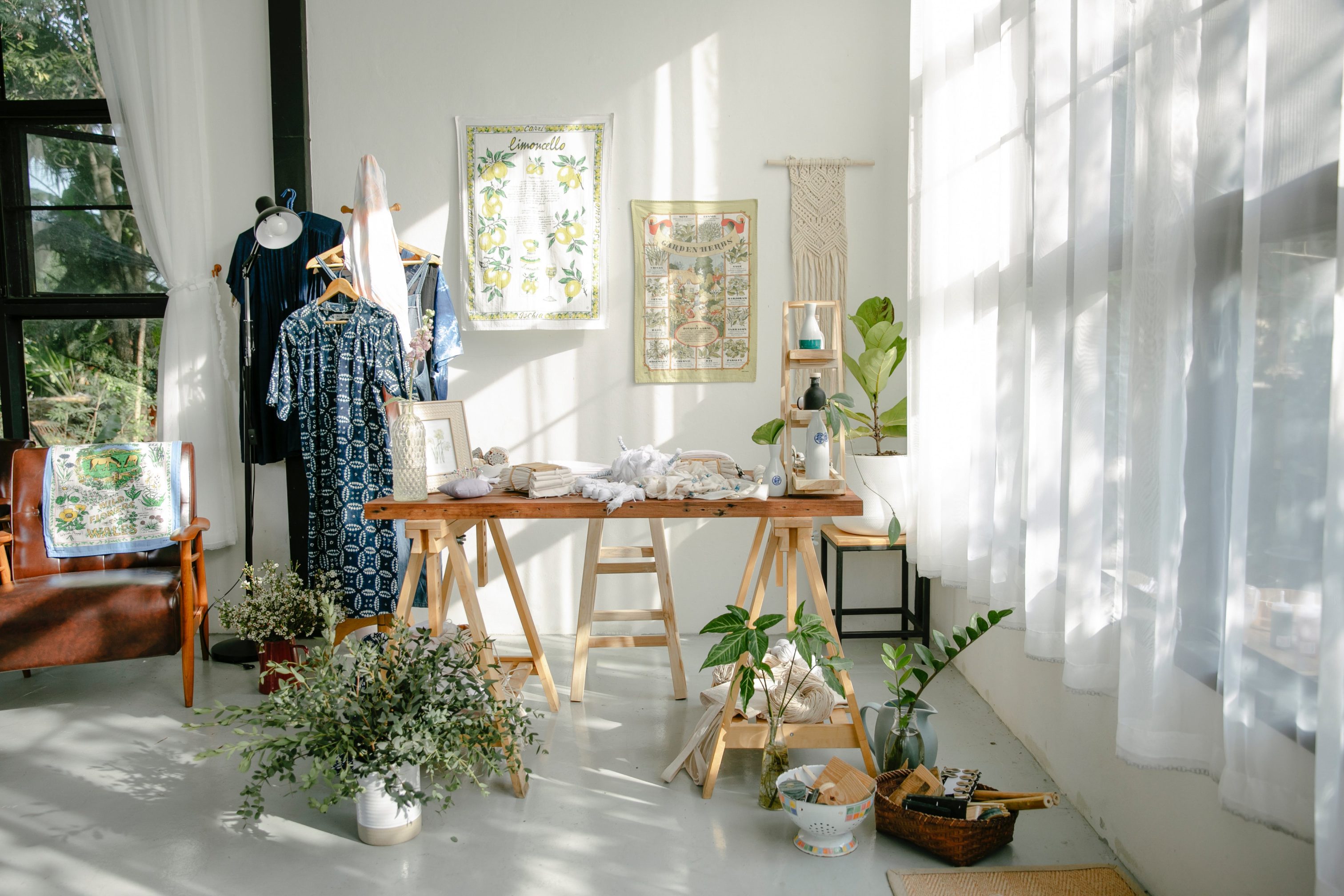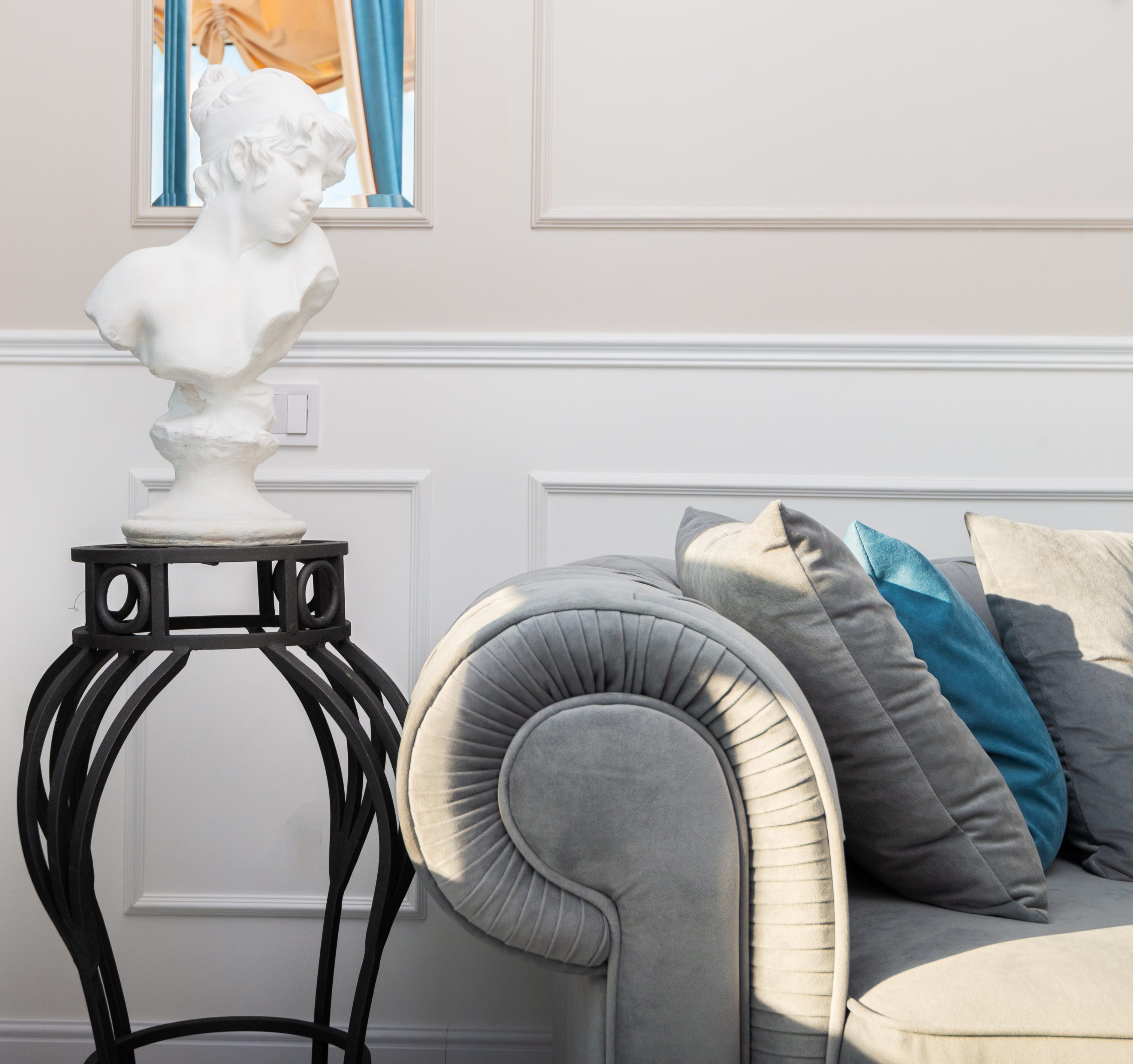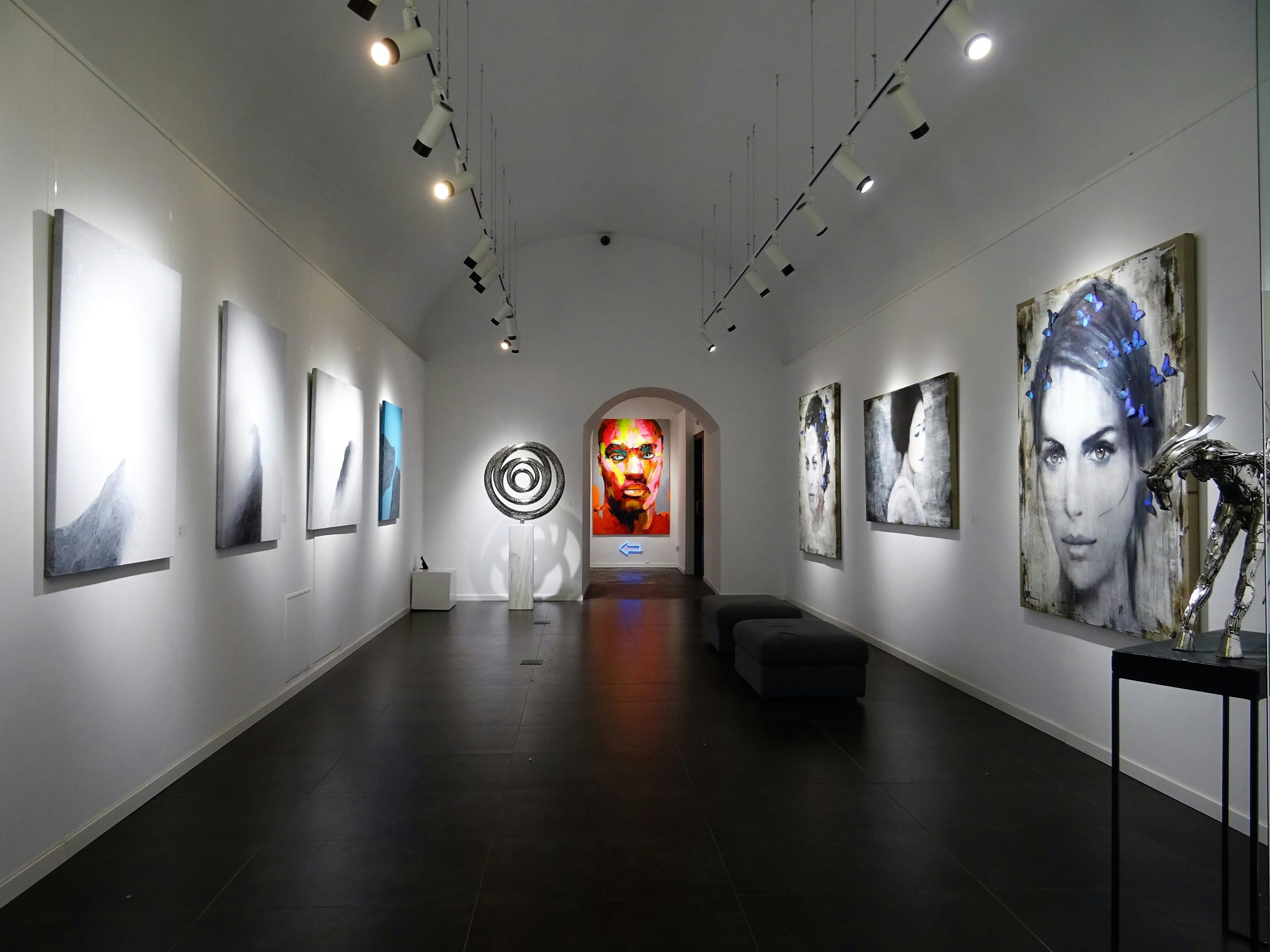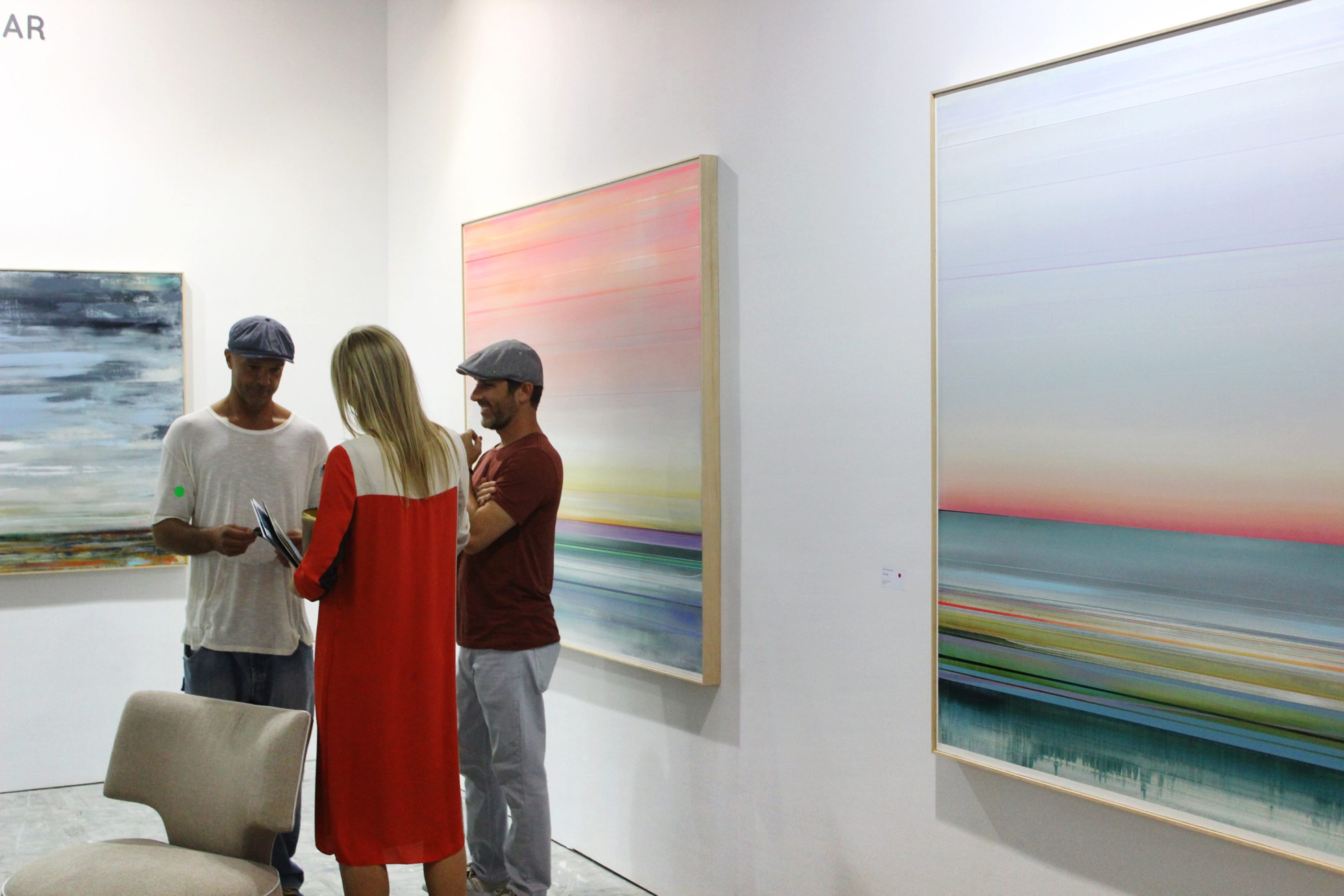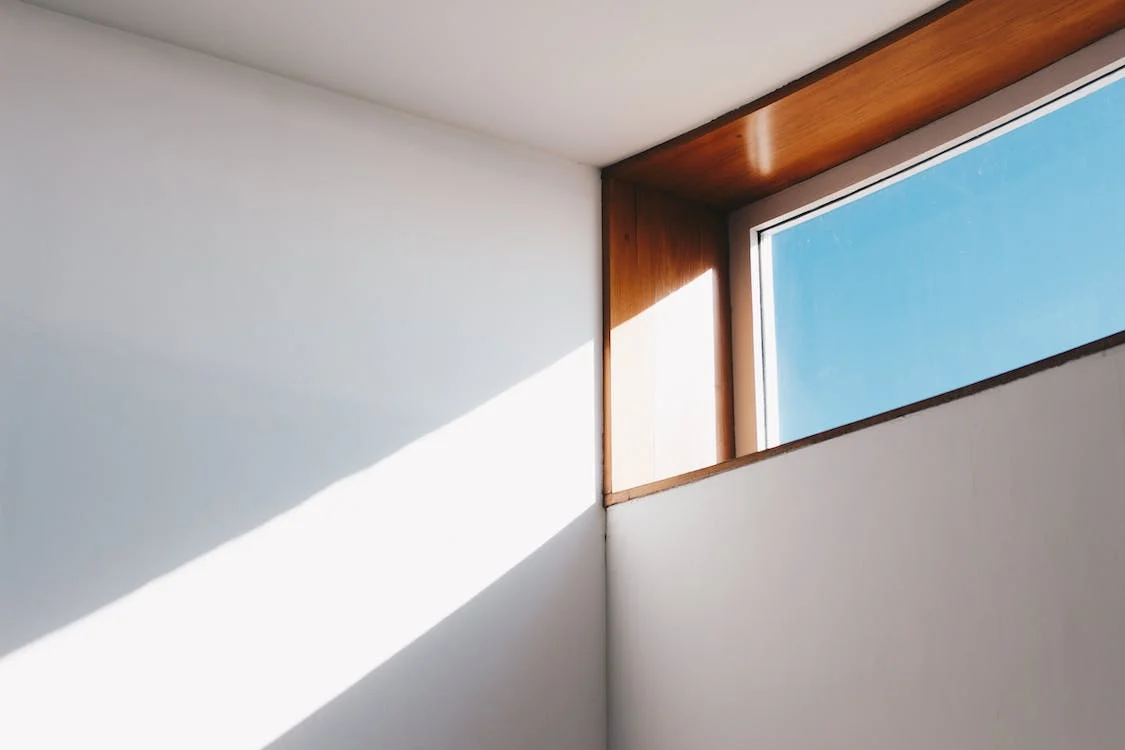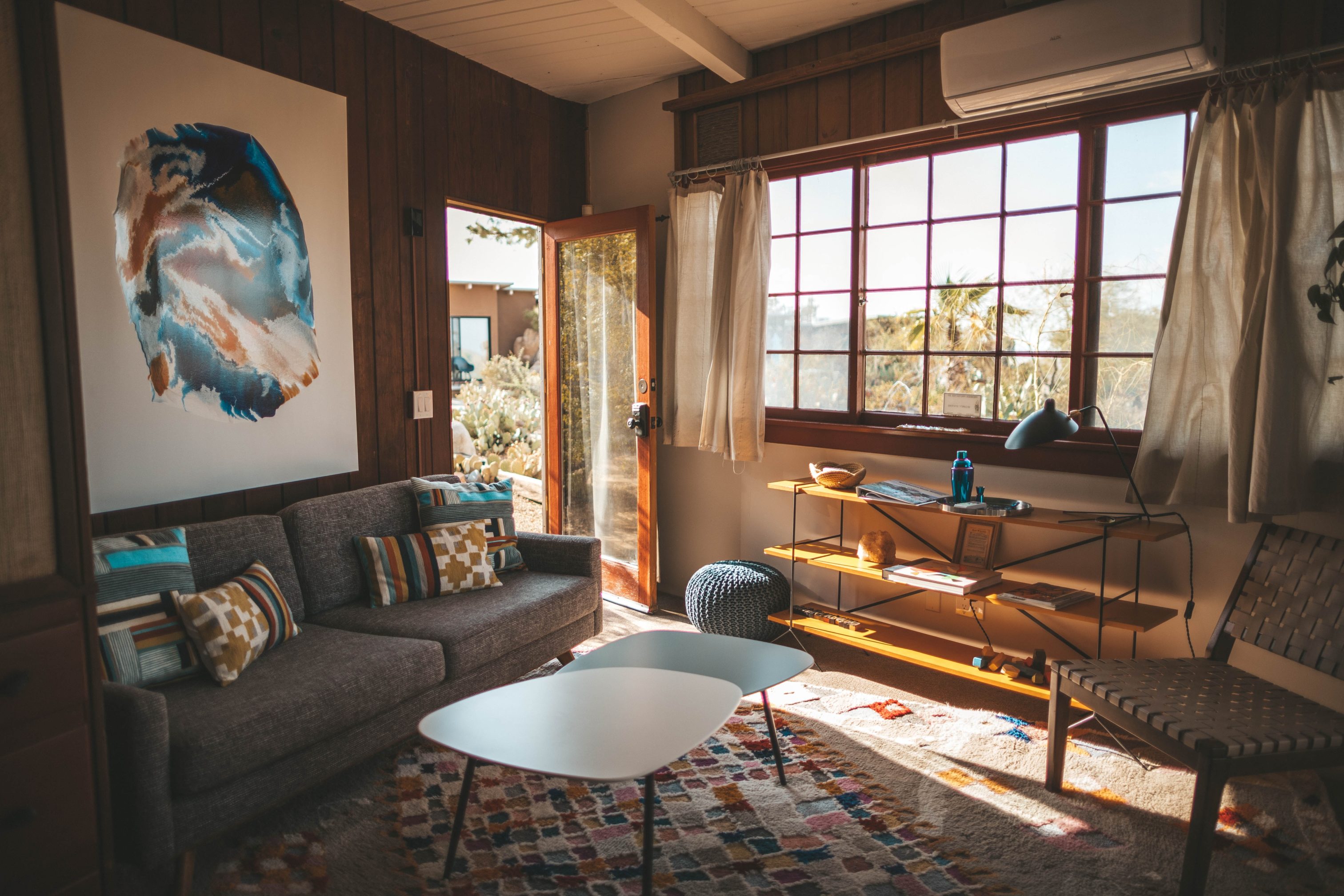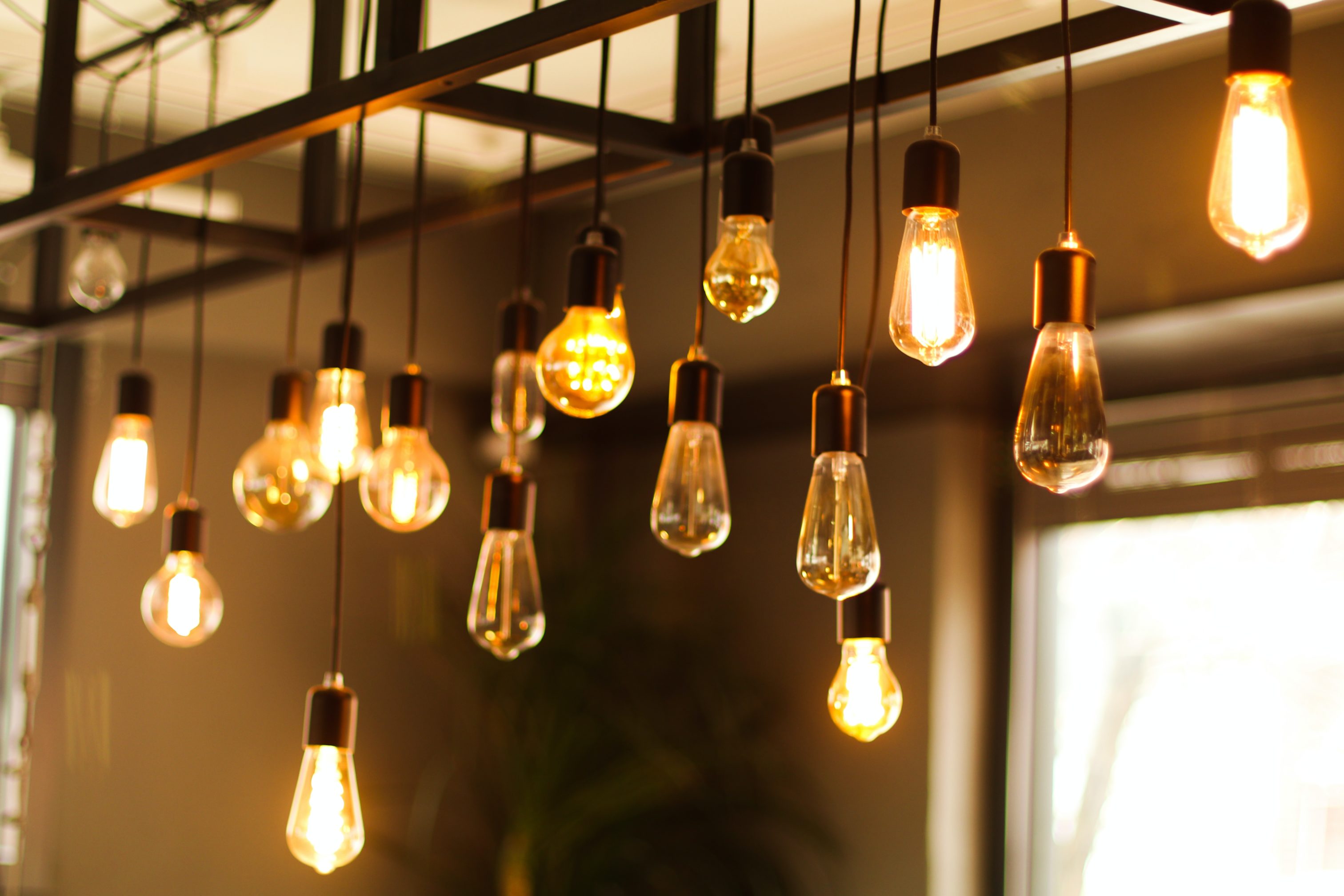Perfect lighting for your paintings combines science and artistry to showcase your artwork’s true beauty while protecting it from damage. LED lighting systems offer the best solution with customisable colour temperatures (2700K-3500K), minimal UV emission, and energy efficiency. Key factors include proper fixture placement, glare elimination, and matching light temperature to your artwork type. Professional lighting for your paintings can transform any space into a gallery-quality display.
Table of Contents
- Why Does Lighting Make Such a Dramatic Impact on Art?
- What is the Science Behind Perfect Art Lighting?
- How Should You Customise Lighting for Different Types of Artwork?
- Should You Choose Natural vs. Artificial Lighting for Your Art Display?
- How Do You Select the Ideal Light Source for Your Artwork Display?
- What Are the Best Light Fixtures for Your Art Display?
- How Can You Eliminate Glare and Enhance Visual Impact?
- How Do You Achieve Consistency and Balance in Your Lighting Setup?
- How Do You Maintain Your Art Lighting System?
- Key Takeaways
- FAQs
Art is not just about the medium or the brush strokes – it’s also about how the piece is presented through strategic lighting for art display. Whether you’re a dedicated art collector, gallery owner, or someone who cherishes art in your home, understanding how lighting works in art is crucial for creating impactful presentations. Lighting plays a dual role in art – it protects paintings while enhancing their visual appeal. The advent of LED lighting has transformed how artists and galleries illuminate artwork. Professional artwork display light solutions not only highlight your collection’s vibrant colours and textures but also protect pieces from damage over time, making proper illumination an essential investment for any art enthusiast. In this guide, we dive deep into art illumination, offering actionable advice, scientific insights, and creative inspiration to help you achieve the best lighting for your paintings.
By exploring everything from the science of light to advanced techniques for LED lighting for artists, you’ll learn how proper artwork display light highlights your artwork’s vibrant colours and textures and protects it from damage over time. For comprehensive guidance on display strategies, check out our detailed art display tips blog.
1. Why Does Lighting Make Such a Dramatic Impact on Art?
Lighting for your paintings is a silent storyteller that can transform a painting from a static image into an immersive experience. Proper lighting for your paintings enhances the artwork’s depth, texture, and overall visual appeal, while poor lighting may obscure details or even alter the colours.
How Does Lighting Influence Perception in Art Displays?
Colour Accuracy and Vibrancy: When lit properly, a painting’s hues and tones come alive, revealing its true depth and vibrancy. Light can intensify or muffle colours, so choosing the right lighting for your paintings is essential. Consider these key factors:
- Warm LED lighting can enrich oil paintings with deep, vibrant colours
- Cooler light may better suit watercolours and pastel works
- Proper colour temperature matching prevents colour distortion
- Quality lighting for your paintings preserves original artistic intent
Texture and Detail: Lighting for your paintings is crucial in revealing the intricate details and brushstrokes that define a painting’s texture. Strategic illumination creates shadows and highlights that add dimensionality, allowing viewers to appreciate the subtle nuances in the artwork through these benefits:
-
- Enhanced visibility of brush strokes and artistic techniques
- Improved three-dimensional appearance of textured surfaces
- Better appreciation of layered paint applications
- Increased visual depth and artistic impact
Mood and Ambience: Professional lighting for your paintings can create an ambience that evokes specific emotions. A softly lit room with proper illumination can create an intimate atmosphere, perfect for contemplative art, while bright, focused lighting for your paintings might energise a modern, dynamic space.
What Are the Psychological Effects of Light on Art Viewing?
Beyond mere visibility, lighting for art display can affect how viewers emotionally connect with pieces. Light and shadow through strategic artwork display light can influence mood, making a painting more dramatic, serene, or mysterious. Research from the International Association of Lighting Designers notes that the experience of art is visual and emotional, with lighting acting as a bridge between the two.
Understanding these impacts sets the stage for making informed decisions about lighting for your paintings. With a clear grasp of how lighting works, you can tailor your strategy to enhance every unique piece in your collection.
2. What is the Science Behind Perfect Art Lighting?
To master lighting for your paintings, you must understand some basic scientific concepts that govern how light behaves and interacts with art.
How Does Colour Temperature Affect Your Artwork Display?
Colour temperature, measured in Kelvin (K), describes the hue of a light source and is fundamental to understanding how lighting for your paintings works:
- Warm Light (Below 3000K): Produces a soft, yellowish glow that enhances the warm tones in artworks like oil paintings
- Neutral Light (3000K to 4000K): A balanced light that works well for most art forms
- Cool Light (Above 4000K): Emits a bluish tone, ideal for modern art or pieces with cool palettes
Remember that choosing the proper lighting for your paintings means matching the light’s colour temperature to your artwork’s palette. A mismatch can lead to colour distortion and reduced visual impact.
Why Are Intensity and Distribution Critical for Artwork Display?
The intensity of the lighting for your paintings – how bright or dim it is – can be just as crucial as its hue. Consider these important factors:
- Overly intense light might wash out details
- Too little illumination may obscure the art
- Even light distribution across the painting is vital
- Uneven lighting for your paintings can create distracting shadows or hot spots
How Can You Protect Art from UV Damage?
Many traditional light sources, such as incandescent bulbs and some fluorescents, emit ultraviolet (UV) rays that can damage delicate artworks over time. UV exposure can lead to fading, discolouration, and deterioration of pigments. Modern LED lighting for artists is popular because it typically produces minimal UV emissions while offering customisable brightness and colour temperature.
The Smithsonian Institution’s Conservation Guidelines recommend limiting UV exposure to preserve artwork integrity for future generations.
In summary, understanding these scientific aspects will empower you to select and fine-tune the lighting for paintings so that they showcase their best qualities and protect them for years to come.
3. How Should You Customise Lighting for Different Types of Artwork?
No two paintings are the same, neither should the lighting for your painting solutions be. Different art forms demand different approaches to effective illumination.
What’s the Best Lighting for Oil Paintings?
Oil paintings are renowned for their depth and rich textures. To highlight these features with proper lighting for your paintings:
- Use Intense, Focused Lighting: Enhance oil paintings’ deep, layered colours with LED lighting that can be directed precisely
- Opt for Warm Colour Temperatures: A warm lighting for your painting (around 2700K to 3000K) accentuates the natural warmth of oil paints.
- Consider Adjustable Fixtures: Track lighting works well for flexible lighting for positioning your paintings.
- Maintain Proper Distance: Ensure adequate space between the light source and the artwork.
How Does Lighting Work for Watercolours and Pastels?
Watercolours are delicate, often featuring subtle gradations and soft hues. For these works, proper lighting for your paintings requires:
- Employ Soft, Diffused Lighting: Avoid harsh, direct light that can cause glare or uneven exposure
- Choose Neutral to Cool Temperatures: Neutral lighting for your paintings (around 3500K) maintains the integrity of pastel tones
- Use Lower Intensity: Delicate works require gentler illumination
- Consider UV Protection: Extra protection for light-sensitive materials
What About Mixed Media and 3D Art Lighting?
Mixed media pieces or three-dimensional art can incorporate a variety of materials, each reflecting light differently:
- Versatile Lighting Setups: Use adjustable LED fixtures that can be repositioned to highlight different aspects.
- Dynamic Colour Temperatures: Some elements may benefit from warmer tones, while others shine under cooler light.
- Multiple Light Sources: Consider approaches that provide layered lighting for your painting.
- Flexible Control Systems: Modern LED systems that allow for dynamic adjustments are ideal.
For more creative display inspiration, explore our guide on creative painting display ideas.
Tailoring your approach to the type of artwork – whether paintings, sculptures, or installations – enhances its visual impact and ensures that each piece receives the ideal lighting for art display.
For more advanced techniques, explore professional gallery lighting methods used by major institutions worldwide.
4. Should You Choose Natural vs. Artificial Lighting for Your Art Display?
When planning the illumination of your art, one of the first decisions is whether to rely on natural light, artificial lighting for your paintings, or a combination of both.
What Are the Pros and Cons of Natural Lighting for Paintings?
Advantages:
- Soft and Dynamic: Natural daylight offers a gentle, ever-changing illumination that can reveal the nuances of a painting’s colours when considering how lighting works in art.
- Cost-Free Energy: Natural light can reduce energy costs, making it eco-friendly lighting for paintings.
Challenges:
- Inconsistency: The quality and intensity of natural light vary throughout the day and seasons, making it challenging to maintain a consistent display of light.
- UV Exposure: Even natural light contains UV rays that can be harmful over time, so additional measures, such as UV-filtering window films, may be required for proper lighting for art display.
Why is LED Lighting for Artists Superior to Natural Light?
Advantages:
- Control and Consistency: LED lighting for artists allows you to tailor the brightness, colour temperature, and direction, ensuring a consistent display of your art.
- Versatility: Modern lighting for paintings include various options, mainly LEDs, offering customisable features that can mimic natural light while protecting your paintings from UV damage.
Challenges:
- Initial Investment: High-quality lighting for art display can be expensive, though they typically pay off in the long run with lower energy consumption and improved longevity.
- Heat Production: Some artificial lights, such as traditional incandescent bulbs, generate heat that might affect sensitive artwork. Opting for cooler alternatives, like LED lighting for artists, can help mitigate this risk.
For many art enthusiasts, a hybrid approach – combining natural and artwork display light – provides the best of both worlds. By carefully balancing these sources, you can achieve consistent and adequate lighting for paintings regardless of the time of day.
5. How Do You Select the Ideal Light Source for Your Artwork Display Light?
Choosing the correct type of light source is crucial to ensure that your artwork is beautifully displayed and well-protected with optimal lighting for art display.
Is Incandescent Lighting Suitable for Art Display?
Pros:
- Warm, Natural Glow: Incandescent bulbs create a soft, warm lighting for paintings that enhances traditional art forms.
- Simplicity: They are widely available and easy to install for basic artwork display light setups.
Cons:
- Heat Production: The heat generated can be problematic for delicate artworks, and based to how lighting works in art reveals that energy efficiency is relatively low.
- UV Emission: They emit UV rays that, over time, may contribute to the deterioration of certain pigments in lighting for art display.
What About Fluorescent Lighting for Paintings?
Pros:
- Energy Efficiency: Fluorescent lights are more energy-efficient than incandescent bulbs for artwork display light.
- Even Illumination: They provide a broad, even spread of light suitable for many lighting applications for art display.
Cons:
- Colour Accuracy Issues: These lights can sometimes cast a bluish or greenish hue, which may distort the natural colours of your paintings.
- Flicker and Hum: Older fluorescent models might produce a noticeable flicker or hum, detracting from the lighting for paintings viewing experience.
Why is LED Lighting for Artists the Best Choice?
Pros:
- Customisable and Versatile: LED lighting for artists has become the go-to choice for modern artwork display light. They offer adjustable brightness and colour temperature, making them ideal for fine-tuning lighting for paintings.
- Energy-Efficient and Long-Lasting: LEDs protect artwork while lowering energy costs, emitting minimal UV rays and producing reduced heat for superior lighting for art display.
- Smart Integration: Many LED lighting for artists systems now have smart features, allowing you to control lighting for art display via apps or voice commands.
Cons:
- Higher Initial Cost: While the upfront investment can be higher, the long-term savings in energy and maintenance often justify the expense for quality artwork display lighting.
According to LED industry research, LED technology has advanced significantly, making it the preferred choice for applications that provide lighting for your art.
When selecting a light source, consider the specific needs of your artwork and how lighting works in art. For most art collectors and galleries, the benefits of LED lighting for artists – especially its energy efficiency and customisability – make it the ideal choice for achieving perfect lighting for paintings.
6. What Are the Best Light Fixtures for Your Art Display?
Beyond choosing the right light source, the fixtures that hold your lights play a significant role in the overall effectiveness of your lighting for art display.
How Does Track Lighting Work for Art Displays?
- Adjustability: Track lighting for painting systems directs light precisely where needed. Their flexible design allows you to adjust the angle and position of each fixture to highlight specific areas of a painting.
- Modern Aesthetics: Track LED lighting for artists, with sleek, contemporary designs, not only illuminates your art but also adds to the overall decor while providing superior artwork display light.
Are Wall-Mounted Fixtures Effective for Artwork Display Light?
- Discreet and Efficient: Wall-mounted fixtures offer a minimalist look that keeps the focus on your artwork while providing ample lighting for art display.
- Customisable Arrangements: They can create a balanced light distribution across multiple pieces, ensuring consistent lighting for paintings throughout your gallery or living space.
What Makes Picture Lights Special for Lighting for Paintings?
- Designed for Art: Picture lights are engineered specifically for artwork display light. They often come with features that help reduce glare and focus the light directly on the art.
- Easy Integration: These LED lighting for artists solutions can be mounted directly above or around the painting, providing targeted and professional lighting for art display.
For professional fixture recommendations, consult lighting design specialists who work with museums and galleries.
Choosing the right fixtures is as crucial as selecting the appropriate light source. When planning your lighting for paintings strategy and understanding how lighting works in art, consider the style of your space and the specific requirements of each artwork.
7. How Can You Eliminate Glare and Enhance Visual Impact?
Glare can severely detract from the viewing experience by washing out details and causing reflections that distract from the artwork. Here are effective strategies to combat glare in your lighting for an art display setup:
What Anti-Reflective Materials Work Best?
- Anti-reflective Glass or Acrylic: Consider using anti-reflective glass or acrylic when framing your paintings. These materials help minimise reflections, ensuring the viewer focuses on the art with proper artwork display lighting.
- Matte Finishes: Matte or non-gloss finishes on frames can also help reduce glare, especially in well-lit environments with LED lighting for artists.
How Should You Adjust the Angle of Light?
- Experiment with Fixture Positioning: Small changes in the angle of your lighting for painting fixtures can make a significant difference. Try positioning LED lighting for artists slightly above or to the side of the painting to prevent direct light from bouncing off the surface.
- Utilise Diffusers: Diffusers or softboxes can scatter artwork display light more evenly, softening the light’s intensity and reducing harsh shadows in your lighting for art display.
Why Does Creating a Buffer Zone Matter?
- Distance Matters: Ensure a small gap between the light source and the painting. This buffer zone helps diffuse the lighting for paintings before it hits the artwork, minimising hotspots and glare.
Professional framers and art conservation experts recommend these techniques for optimal art presentation.
By actively addressing glare issues and understanding how lighting works in art, you can dramatically enhance the visual impact of your artwork and ensure that the lighting for art display is both practical and aesthetically pleasing.
8. How Do You Achieve Consistency and Balance in Your Lighting Setup?
Consistency in lighting for art display is key, especially when displaying multiple pieces together. A well-balanced lighting plan for paintings ensures that each painting is equally illuminated and no single artwork overshadows another.
What Strategies Ensure Consistent Artwork Display Light?
- Uniform Fixture Placement: Arrange your LED lighting for artist’s fixtures to spread light evenly across the entire display area. This prevents areas of over- or under-illumination in your lighting for art display.
- Use Dimmers: Installing dimmers on your lighting for painting systems allows you to fine-tune the brightness, ensuring that each piece receives the optimal amount of artwork display light.
- Layered Lighting Approach: Combining ambient, task, and accent LED lighting for artists can help create a balanced environment that highlights the artwork while setting the desired mood.
Why is a Holistic Experience Important?
Consistency improves the visual appeal and reinforces the importance of thoughtful lighting for art display, ensuring that every piece in your collection is showcased to its fullest potential with proper artwork display lighting.
9. How Do You Maintain Your Art Lighting System?
Even the best lighting for an art display system requires ongoing care to perform at its best. Regular maintenance ensures that your LED lighting for artists setup will consistently deliver the perfect lighting for paintings.
What Are Essential Maintenance Tips?
- Cleaning Fixtures and Bulbs: Dust and dirt can reduce the brightness and effectiveness of your artwork display’s light. Regularly clean your fixtures and bulbs to maintain optimal lighting for art display performance.
- Timely Bulb Replacement: Replace bulbs as soon as you notice any dimming or colour shift in your lighting for paintings. This ensures consistent LED lighting for artists and prevents long-term damage to your artwork.
- Check Electrical Connections: Inspect your wiring and connections to avoid flickering or power issues with your artwork display light.
How Do You Troubleshoot Common Issues?
- Uneven Illumination: If you notice uneven lighting for art display, re-evaluate the positioning of your fixtures and consider adjusting the diffusers or reflectors.
- Heat Issues: Ensure that your chosen light source (especially if it doesn’t use LED lighting for artists’ technology) doesn’t generate excessive heat, which could harm your paintings. Understanding how lighting works in art helps you adjust the distance between the light and the artwork if necessary.
Professional maintenance guides are available through electrical contractors specialising in art lighting.
Regular upkeep is essential for sustaining the high-quality display of your art. A well-maintained lighting system for paintings is the backbone of adequate lighting for art display.
Key Takeaways
Perfect lighting for your paintings transforms your art display through these essential principles:
Technical Excellence
- Choose LED lighting for your paintings with 2700K-3500K colour temperature for optimal colour rendering.
- Maintain 200-300 lux brightness for general viewing, 150 lux for delicate works
- Ensure minimal UV emission to prevent artwork damage
- Use adjustable fixtures for flexibility and precision control
Design Strategy
- Match lighting type to artwork medium (warm for oils, neutral for watercolours)
- Implement layered lighting combining ambient, task, and accent illumination.
- Position fixtures to eliminate glare and ensure even distribution
- Create consistent lighting for your paintings across multiple pieces
Protection and Preservation
- Invest in UV-filtering technology to preserve artwork integrity
- Maintain a proper distance between light sources and paintings
- Monitor heat generation to prevent damage to sensitive materials
- Regular maintenance ensures long-term system performance
Professional Results
- Quality lighting for your paintings increases the artwork value perception
- Proper illumination enhances the viewer’s emotional connection
- Strategic lighting creates gallery-quality presentation standards
- Investment in professional systems pays long-term dividends
Conclusion: Transform Your Space with Perfect Lighting for Your Paintings
Achieving perfect lighting for your paintings is a blend of art and science. With the right mix of natural and LED lighting, carefully selected light sources, and thoughtfully designed fixtures, you can create an environment where every brush stroke and hue is showcased to its fullest potential. From understanding the science behind illumination to leveraging the latest smart lighting technologies, each decision is critical in elevating your lighting for your paintings.
The investment in proper lighting for your paintings pays dividends not only in visual appeal but also in artwork preservation. Whether you’re illuminating a single cherished piece or an entire collection, these expert techniques will transform your space into a professional-quality gallery with superior illumination.
Are you ready to transform your art space? Apply these expert tips and techniques for lighting for art display, and you will experience the remarkable difference proper lighting for paintings can make. For additional inspiration and display strategies, explore our comprehensive art lighting tips guide and discover creative painting display ideas to complement your lighting setup.
FAQs
The best lighting for your paintings is LED lighting with a colour temperature between 2700K and 3500K. It offers customisable brightness, low heat output, and minimal UV emission, preserving colour vibrancy while preventing long-term damage through superior illumination.
Use warm lighting for your paintings (2700K–3000K) for oil paintings to enhance rich, warm tones. Use neutral to cool LED lighting (3500K–4000K) for watercolours and modern art to preserve softer hues and cooler palettes
To reduce glare in your lighting for your painting setup, use anti-reflective glass or matte finishes, angle lights above or beside the artwork, and incorporate diffusers. Avoid placing LED lighting directly in front of framed paintings.
Yes, prolonged exposure to natural light can cause fading due to UV rays. To protect your artwork, use UV-filtering glass or films on windows and limit direct sunlight exposure while planning your lighting for your paintings.
LED lighting for your paintings is the safest for artwork display. They produce little heat, emit virtually no UV rays, and offer adjustable brightness and colour temperature, making them ideal for long-term preservation.
For general art viewing, aim for 200–300 lux in your lighting for your painting setup. For more delicate works, like watercolours or textiles, keep the brightness under 150 lux. Use dimmable LED lighting to fine-tune brightness without compromising visibility.
Track lighting offers flexible positioning for multiple pieces, ideal for gallery-style walls. Picture lights are mounted above individual works for targeted art lighting, which is excellent for focused home displays.
Use track LED lighting or wall-mounted fixtures spaced evenly across the wall. Combine ambient and accent lighting, and install dimmers to adjust brightness based on each artwork’s needs for optimal lighting for your paintings.
Yes. LED lighting for your paintings is more energy-efficient, produces less heat, and emits minimal UV radiation, making it safer for artwork preservation than incandescent bulbs in professional display applications.
Clean fixtures and bulbs regularly, replace dimming bulbs promptly, and inspect wiring. Periodic checks prevent uneven illumination, colour shifts, or heat damage to your lighting for your painting system, ensuring continued optimal performance for years to come.


